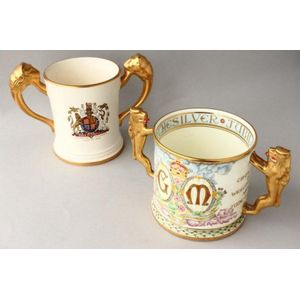Flight Barr & Barr Enamel Jewelled Urn with Monk Portrait
You must be a subscriber, and be logged in to view price and dealer details.
Subscribe Now to view actual auction price for this item
When you subscribe, you have the option of setting the currency in which to display prices to $Au, $US, $NZ or Stg.
- Gilding - Gilding is a method of ornamentation whereby a thin sheet of gold metal is applied to items made of wood, leather, ceramics, glass and silver for decorative purposes.
For furniture including mirrors, the sheet of gold is usually applied over a coating of gesso. Gesso is a mixture of plaster of Paris and gypsum mixed with water and then applied to the carved wooden frames of mirrors and picture frames as a base for applying the gold leaf. After numerous coats of gesso have been applied, allowed to dry and then sanded a coat of "bole", a usually red coloured mixture of clay and glue is brushed on and allowed to dry, after which the gold leaf is applied. Over time parts of the gilding will rub off so the base colour can be seen. In water gilding, this was generally a blue colour, while in oil gilding, the under layer was often yellow. In Victorian times, gilders frequently used red as a pigment beneath the gold leaf.
Metal was often gilded by a process known as fire gilding. Gold mixed with mercury was applied and heated, causing the mercury to evaporate, the long-term effect of which was to kill or disable the craftsman or woman from mercury poisoning. The pursuit of beauty has claimed many victims, not the least of which were the artists who made those pieces so highly sought after today. - Roundel - A roundel is a circular disk, medallion or border on a plate or dish, on an object of furniture. A plate or dish will often have a central circular bordered decoration, termed a roundel. In furniture the word is often used instead of the word 'patera' to describe a turned circular decoration. In recent times use of the word has expanded to encompass any circular area on an object.
This item has been included into following indexes:
Visually similar items

A Spode Imari-manner ink well, circa 1815, decoration pattern 1216, in the form of a classical vase with a pair of serpent handles flanking masks of a man's face to each side of the body, the socle in the form of three addorsed lion's paws, decorated in th

Antique Royal Worcester porcelain twin handled small vase, fruit decoration, date code for 1896

Two twin handled Royal commemorative cups, including Paragon 'Silver Jubilee King George V and HM Queen Mary' and Crown Lynn 'Coronation Souviner June 2nd 1953', height 13.5 cm, 11.5 cm (2)

A gilt bronze and enamel cloissone two handled cup, Qing Dynasty
